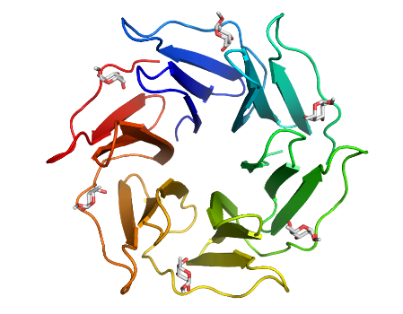Novel recombinant lectins and applications for the detection of pathological state markers
Référence
06433-01
Mots-clés
Statut des brevets
Priority patent application n° FR 14 51740 filed on March 04, 2014, and entitled « Nouvelles lectines et applications pour la détection de marqueurs d’états pathologiques. »
Inventeurs
Anne IMBERTY, Julie ARNAUD, Aymeric AUDFRAY
Statut commercial
Exclusive or non-exclusive license
Laboratoire
Centre de recherches sur les macromolécules végétales (CERMAV,UPR5301 ), Grenoble, France.
Description
CONTEXT
Changes in cell surface glycosylation are known to be associated with a large number of chronic diseases and the cancer glycans represent a very promising field for biomarker discovery. Among them, specific glycans, such as those terminated by N-acetylglucosamine (GlcNAc) residues are rare on healthy tissues. Other oligosaccharides, rich in fucose (Fuc) residues are markers of inflammation. Lectins have been demonstrated to be very efficient for detecting aberrant glycosylation in biological samples. A new technology is the use of lectin arrays that can contain lectins with large spectra of specificity and therefore characterize variation of glycosylation. The use of lectins extracted from natural organisms may be time-consuming and may generate problems of contamination or variations between batches. Therefore, recombinant lectin technology is starting to be developed.

TECHNICAL DESCRIPTION
The present invention relates to recombinant multimeric lectins having a beta-propeller architecture, formed from repetition and/or oligomerisation of 4 to 7 modules of approximately 30 to 60 amino acids. The concept of neolectins consist in modifying first the valency, creating a monovalent lectin for which the specificity can be engineered, then recreating lectins with chosen number of active binding sites.
BENEFITS
These neolectins have important advantages over extracted lectins. They are recombinant proteins, with higher purity (no contamination) and higher reproducibility than lectins purified from plants of invertebrates. There specificity and valency can be modified to be adapted for recognition of specific epitopes. They are easier, cheaper and faster to produce than antibodies.
INDUSTRIAL APPLICATIONS
This innovation could be used for: – Glycobiology research – Quality control of recombinant glycoproteins (for example for characterizing the glycosylation of therapeutic antibodies) – Diagnostic / Prognostic / Therapeutic follow-up of cancers as leukaemia, adenocarcinoma, kidney, breast and ovary carcinoma, … but also others diseases as rheumatoid arthritis, elderly dementia, … – Diseases treatment, particularly cancers (for drug vectorisation)
DEVELOPMENT STAGE
Accomplished tests: – Production of recombinant lectin from Psathyrella velutina (GlcNAc specific) and Burkholderia ambifaria (Fuc specific) – Production of neolectins from Ralstonia solanacearum with controlled valency – Labeling of human cancer cells and carcinoma tissues Current developments: Modifying the specificity of lectin through phage display approach (Ref 06433-01)
For further information, please contact us (Ref 06433-01)
Besoin de plus d'informations ?
Nous contacterTechnologies Liées
-
08.02.2017
Method for determining the size distribution of a mixture of particles of (macro)molecules using taylor dispersion and associated system
Chimie, Santé / Thérapeutique, Diagnostic médical, Matériaux – Revêtements 00957-03
-
27.07.2015
A new class of compounds, inhibitors of advanced glycation end-products (AGE) formation, to prevent the deleterious effects of aging due to the formation of AGE
Santé / Thérapeutique, Autres technologies 01418-01
-
31.03.2015
Protein involved in DNA replication, and modulation of its activity
Santé / Thérapeutique, Diagnostic médical 06081-01